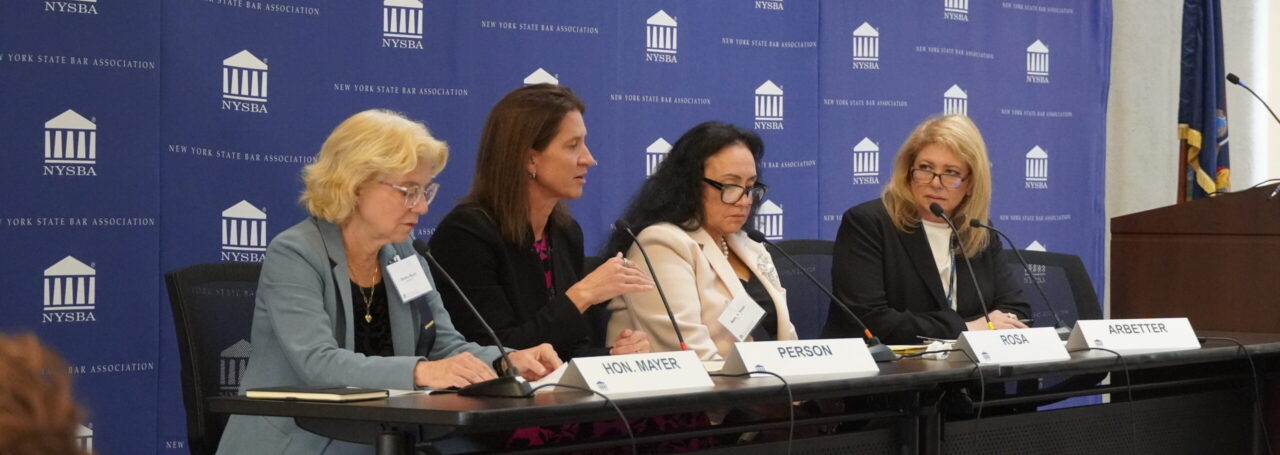Judging the Credibility of What You Read
4.14.2025

In an era of unprecedented access to information, navigating the digital landscape has become a critical skill for students. Media literacy – the ability to analyze, evaluate and create media content responsibly – is no longer an optional component of education but a necessity. As misinformation proliferates and social media platforms dominate communication, the need for robust media literacy education in the United States is more urgent than ever.
The theme of the New York State Bar Association’s second Civics Convocation, to be held in October 2025, will be media literacy. We will examine a range of issues related to the state of media literacy education in New York in comparison to other states and other countries.
The Importance of Media Literacy Education
The digital revolution has transformed the way we all consume and disseminate information. Students today are growing up in a world saturated with media, from traditional outlets like television and newspapers to myriad digital platforms. One of the primary reasons media literacy education is crucial is its role in combating misinformation, especially at a time when Meta, a leading platform, has abandoned fact-checking, and other platforms may follow suit. False or misleading information can influence public opinion, erode trust in institutions and impact democratic processes. Teaching students to use critical thinking to evaluate sources, verify facts and recognize bias helps them become discerning adult consumers of information.
Media literacy also promotes active citizenship. Understanding how media influences political discourse empowers us to identify propaganda and participate more effectively in democratic processes. It fosters digital resilience, equipping students with tools to navigate online spaces safely and responsibly. This includes recognizing cyberbullying, understanding privacy issues and becoming aware of how algorithms shape their media consumption.
But beyond critical consumption, media literacy also involves media creation. Students need the tools to express themselves through various media formats, developing skills that are increasingly valuable and necessary in the modern workforce.
New York State
New York State does not have a statewide mandate requiring media literacy education across all schools, although several school districts have incorporated it into their curricula. Additionally, the state has funded initiatives aimed at providing teachers with resources and training to address misinformation and promote critical thinking.
Advocates argue that a statewide plan to integrate media literacy into education from kindergarten through grade 12 is crucial. Some recommendations include establishing a task force, aligning media literacy with existing standards and providing professional development for educators to incorporate these skills effectively into their teaching.
Nan Mead and Chris Sperry of DemocracyReady NY’s Media Literacy Committee,[1] in an opinion piece in the Times Union, advocate for media literacy education, asserting that it is an essential skill for the digital age preparing students to enter civic life. They note, “Are New York’s schools equipping our youth with the critical skills needed to navigate this complex media landscape? Not yet – but state leaders can change that. It’s time for education officials and policymakers to make media literacy a core requirement in our state’s education system.”[2]
They credit Gov. Kathy Hochul for taking steps to emphasize the importance of media literacy. She directed the Department of Homeland Security and Emergency Services to create a media literacy toolkit for educators, but this effort was more of a response to immediate needs for student safety online, rather than a comprehensive, systematic curriculum requirement. Mead and Sperry write that New York has “fallen behind” the 20 states that have passed legislation to promote media literacy education, including New Jersey, which requires it, noting, “Although state lawmakers have initiated numerous bills over the past three legislative sessions, not one has made it out of committee.”[3] Mead and Sperry say that DemocracyReady NY, a statewide coalition of advocates, civic groups, educators and youth organizations, has given state officials a media literacy action plan.
What steps are required? Mead and Sperry urge Education Commissioner Betty Rosa, the Board of Regents and other education officials to
immediately establish a statewide task force for media literacy integration. The state should also identify and fund promising media literacy education programs already emerging across the state. Finally the state must expand efforts to ensure that certified school library media specialists are employed in all New York schools, a move that will be critical to providing all students with an appropriate media literacy education.[4]
Conversations between DemocracyReady NY leaders and the commissioner of education and senior staff have signaled support for the goals that DemocracyReady NY has articulated. They support the end goal to ensure media literacy is provided in New York schools. Just how it will become an established part of the curriculum is under discussion.
Comparing Media Literacy Education in New Jersey to New York
New Jersey has made notable strides in promoting media literacy education. In January 2023, Gov. Phil Murphy signed legislation, with bipartisan legislative support, that will make New Jersey the first state to require comprehensive media literacy curriculum for K-12 students.[5] The Senate’s version lead sponsor, Republican Sen. Mike Testa said, “This law isn’t about teaching kids that any specific idea is true or false. Rather, it’s about helping them learn how to research, evaluate, and understand the information they are presented for themselves.” Under the new law, the New Jersey Department of Education will develop literacy curriculum standards each school district will have to incorporate “in an appropriate place in the [district’s] curriculum.” The law also mandates the development of standards and professional training programs for educators, making New Jersey one of the most proactive states in addressing the issue. School library media specialists and teachers will be closely involved.[6]
United States: Other State Laws and Policies on Media Literacy Education
It is estimated that 84% of U.S. adults support the introduction of media literacy into school curricula – even though only 38% of said adults had received such education themselves. At present, 18 states have introduced mandatory media literacy education to help students identify misinformation.[7]
At the federal level, there have been calls to at least promote media literacy, but comprehensive legislation has yet to be enacted. Initiatives like the Digital Citizenship and Media Literacy Act, introduced in Congress, aim to provide funding and support for media literacy programs, but progress has been slow.[8] Given that our federal system leaves education policy to the states, there is a patchwork approach to teaching media literacy.
In 2023, California’s Gov. Gavin Newsom signed a bill into law on behalf of its roughly 6 million school-aged children in public schools requiring that new media standards be embedded into English language arts, science, math and history classrooms – the four core subjects that all students learn from kindergarten through 12th grade. The law brings California in line with a small but growing number of states teaching media literacy in grade school. New Jersey and Delaware have passed similar laws. In 2021, Illinois mandated a stand-alone media literacy class in all public high schools. Unfortunately, according to educators and others, classroom implementation has been slow to materialize, due to a lack of guidance, funding and oversight.[9]
According to the Media Literacy Now Policy Report 2023, some other states are moving toward media literacy educational mandates. Connecticut is requiring media literacy to be integrated into social studies, with funding allocated to do so. Florida’s new law on social media will provide essential learning for media literacy for the state’s nearly 3 million public school students. New Mexico, one of the earliest states to pass media literacy legislation, is now requiring professional development for teachers. Four additional states, Georgia, Minnesota, New Hampshire and Virginia, have regulations requiring media literacy training for teacher prep programs or credentialing.[10] Washington state has passed legislation to develop best practices for teaching it and has also encouraged collaboration between educators and librarians to integrate media literacy into the curriculum. While some states have embraced media literacy, others have taken limited or no action. For example, Mississippi and Alabama lack formal policies or mandates for media literacy education. This disparity creates significant inequities in students’ preparedness to navigate the digital world.
Finland: The Gold Standard of Teaching Media Literacy
Finland consistently ranks first in Europe for media literacy and resilience against misinformation. Other countries look to Finland as a model with its robust education system and strong popular trust in its press. Unfortunately for the implementation of media literacy education, the United States is not the cohesive society that Finland is, but we in New York can benefit from examining how a unified effort can change the landscape for all our students.
Finland’s success in combating fake news stems from a comprehensive, society-wide approach emphasizing education and media literacy. Since launching an anti-fake news initiative in 2014 to combat neighboring Russian bots and Kremlin-backed disinformation campaigns, Finland has integrated critical thinking into its education system, teaching students and citizens alike how to navigate the internet.
Finland reformed its education system in 2016 to emphasize critical thinking for all students from kindergarten to high school. They are taught to identify misinformation, understand media bias and fact-check information on YouTube and social media posts. They are taught to recognize tactics like emotional manipulation in clickbait and practice creating fake news to understand how it works. Finnish schools collaborate with organizations like Faktabaari (FactBar) to develop resources, such as a digital literacy toolkit, which are shared across the EU.
A crucial element in the effectiveness of teaching media literacy is that Finland sees countering misinformation as a collective responsibility. The government has trained more than 10,000 citizens, including politicians and journalists, to detect and counter false narratives. Probably most important, at least for teens, students are encouraged to critically evaluate content before sharing it on social media. This ethos extends beyond classrooms, cultivating a culture of healthy skepticism.[11]
Student Perspectives and Demand for Media Literacy
The internet was designed by adults, for adults, but a third of global users are children. And we need media literacy to be core to the curriculum, embedded into different subjects through critical thinking.[12]
– Alex Cooney, chief executive of CyberSafeKids
Students themselves have voiced a strong desire for more media literacy education. The media landscape presents opportunities for learning and creativity but also exposes students to challenges like misinformation, cyberbullying and manipulation by algorithms. A recent 2023 survey conducted by the Pew Research Center revealed that 68% of high school students believe they are not adequately prepared to evaluate the credibility of online information. Furthermore, 72% expressed a desire for schools to offer more comprehensive lessons on recognizing bias, identifying misinformation and understanding media algorithms. Today, more than half of teens get their news from social media platforms like YouTube, Instagram and TikTok, and a third of kids ages 10-17 trust online influencers more than they do newspapers, according to Common Sense Media and the U.K.’s Office of Communications, respectively.[13] A study surveying teen internet knowledge, habits and skills conducted by the News Literacy Project, a nonpartisan education nonprofit, concluded “that American teens are awash in conspiracy theories and are cynical about the news media.” Eight out of 10 teens say conspiracy theories come across their social media at least once weekly; 81% believe at least one of them. Based on this survey, the students (94%) want media literacy instruction in school, but only 39% reported receiving it.[14]
In its U.S. Media Literacy Policy Report 2023, the nonprofit advocacy group Media Literacy Now stated, “This was the year that media literacy reached critical mass. There is far more widespread acceptance today than ever that media literacy instruction is essential to K–12 education.”[15]
Perspectives From Educators and Librarians
Adults who work directly with students, such as teachers and librarians, are on the front lines of media literacy education. Their insights reveal both the progress made and the challenges that remain.
Teachers recognize the importance of media literacy but often struggle with limited resources and training. A 2020 survey by Media Literacy Now found that while 80% of teachers agreed that media literacy is essential, only 20% felt adequately prepared to teach it. Time constraints and a lack of standardized curricula further hinder their efforts. Teachers face challenges in implementation. Many teachers report that integrating media literacy into existing curricula is difficult due to competing priorities. Subjects like math and science often take precedence, leaving little room for media literacy lessons.
Despite these challenges, some teachers have found innovative ways to incorporate media literacy. For instance, English teachers use literature analysis as a gateway to discuss media bias, while history teachers explore how media has shaped historical events.
A California teacher named William Colglazier recently gave students an assignment related to the USS Maine episode. An early example of “yellow journalism,” today’s “fake news,” was “Remember the Maine, to hell with Spain!” Newspapers blamed Spain for the USS Maine explosion without clear evidence as to the cause. The public outcry at the death of 268 sailors led President McKinley to ask Congress for permission to intervene in Cuba on April 11, 1898; the blockade of Cuba and Spain began 10 days later. Spain declared war on April 23, and Congress issued an official declaration of war on April 25. The history teacher provided students with sources from Filipino and Cuban textbooks claiming it was an intentional explosion done by U.S. spies, just the type of conspiracy theory they see on their everyday social media feeds. Using the technique of lateral reading, the students looked for, but couldn’t find, supportive evidence. “It is very telling that there’s no revelation in scholarship or in a New York Times story about this,” Colglazier said. “And so they begin to kind of piece together that, well, this claim isn’t verified, and the sinking was probably an accident.”[16] This type of lesson makes students think twice about conspiracy theory claims they come across every day on social media.
Librarians play a crucial role in media literacy education, often serving as the go-to experts on information evaluation. They provide resources, conduct workshops and collaborate with teachers to design media literacy programs. School and public libraries frequently act as resource hubs, offering access to databases, fact-checking tools and educational materials. Librarians have been vocal advocates for media literacy legislation, emphasizing its importance in preparing students for a digital world.
Parents and community members are increasingly aware of the need for media literacy education, particularly as concerns about misinformation and online safety grow. Many support initiatives to incorporate media literacy into school curricula and advocate for greater investment in teacher training and resources.
The Future of Media Literacy Education
The growing awareness of media literacy’s importance is encouraging, but significant work remains to ensure that all students have access to this vital education.
- We should invest in teacher training. Providing educators with the training and resources they need to teach media literacy effectively is critical. Professional development programs, funded by state and federal governments, could bridge the gap.
- We should leverage technology. Many tools and online platforms offer innovative ways to teach media literacy. Interactive games, simulations and virtual workshops can make learning engaging and accessible.
- We should build partnerships. Collaboration among schools, libraries, nonprofits and tech companies can amplify efforts to promote media literacy. For example, organizations like the News Literacy Project, NAMLE, Project LookSharp, Consortium for Media Literacy, Common Sense Media, iCivics, the Center for Civic Education, Snopes and other fact-checking organizations are resources for educators and students as well as all adults.
Media literacy education is not just an academic subject but a life skill essential for thriving in today’s digital age. While progress has been made, the fragmented nature of state policies and the challenges faced by educators highlight the need for a more coordinated approach. By prioritizing media literacy, investing in teacher training and leveraging technology, the U.S., and New York State in particular, can prepare its students to navigate the complexities of the modern media landscape. The legal profession’s contributions to policy advocacy, resource development and public awareness can further bolster these efforts. As misinformation continues to pose risks to democracy and social cohesion, equipping students with the tools to critically engage with media must become our priority.
Sidebar
How the Legal Profession Can Contribute to Media Literacy Education
The legal profession has an important role to play in advancing media literacy education. Lawyers, judges and policymakers can leverage their expertise to address the systemic gaps in media literacy and promote its inclusion in education.
- Lawyers can advocate for legislation by lobbying for state and federal policies mandating media literacy education. By drafting clear and enforceable legislation, they can help standardize curricula and ensure equitable access to media literacy resources.
- Law firms can offer pro bono services to schools and nonprofits focused on media literacy. This could include helping these organizations navigate grant applications, develop compliance frameworks or establish partnerships with tech companies.
- Lawyers and judges can partner with schools to develop mock trial programs or case studies centered on media law. This approach can incorporate media literacy with related legal concepts.
- Legal experts can work on litigation involving misinformation and its impact on society, setting legal precedents that reinforce the need for media literacy. High-profile cases can draw public attention to the issue and encourage educational reform.
- Lawyers can raise awareness by hosting workshops or seminars for educators, parents and students about the legal implications of media misuse. Topics could include copyright infringement, online harassment and the ethical use of digital content.
Gail Ehrlich has been a prosecutor and legislative counsel for a New York City council member and a social studies teacher at a Bronx high school. After retiring from teaching, she joined the Pace Women’s Justice Center as a pro bono lawyer in the Family Court Legal Program, which aids victims of domestic violence. She is former co-chair of the NYSBA Committee on Law, Youth and Citizenship and now co-chairs the Law, Youth and Citizenship Convocations Committee.
Endnotes:
[1] The author is also a member of this committee and supports its goals.
[2] Nan Eileen Mead and Chris Sperry, Commentary: Make Media Literacy a Core Component of a New York Education, Times Union, Nov. 25, 2024, https://www.timesunion.com/opinion/article/make-media-literacy-core-component-new-york-19937013.php.
[3] S.B. S8217, 2023-24 Leg. (NY 2023); A.B. A8891, 2023-24 Leg (NY 2023).
[4] New York Students Need Media Literacy Education Now, DemocracyReady NY, Oct. 2024, https://democracyreadyny.tc.columbia.edu/media/centers-amp-labs/democracyready-ny/MediaLiteracyEducationActionPlan_1-25.pdf.
[5] NJ S.B. 588 (22R)/NJ A.B. 4169 (22R); Carly Sitrin, New Jersey Becomes First State To Mandate K-12 Students Learn Information Literacy, Politico, Jan. 5, 2023, https://www.politico.com/news/2023/01/05/new-jersey-is-the-first-state-to-mandate-k-12-students-learn-information-literacy-00076352.
[6] Carly Sitrin, New Jersey Becomes First State To Mandate K-12 Students Learn Information Literacy. Politico. Jan. 5, 2023. https://www.politico.com/news/2023/01/05/new-jersey-is-the-first-state-to-mandate-k-12-students-learn-information-literacy-00076352.
[7] Ian Randall, The Right Is More Willing To Spread Fake News, Study Says, Newsweek, Dec. 10, 2024, https://www.newsweek.com/misinformation-fake-news-political-polarization-democrat-republican-1998742;
Zhu, X., & Pechmann, C. Political Polarization Triggers Conservatives’ Misinformation Spread to Attain Ingroup Dominance. Journal of Marketing, 89(1), 39–55, https://doi.org/10.1177/00222429241264997.
[8] Media Literacy Legislation, National Association for Media Literacy Education, https://mlw.namle.org/newsroom/legislation/.
[9] Emily Cooper, Illinois’ Pioneering Media Literacy Program Lacks Resources, Oversight, Gateway Journalism Review, Nov. 3, 2022, https://pulitzercenter.org/stories/illinois-pioneering-media-literacy-program-lacks-resources-oversight.
[10] U.S. Media Literacy Policy Report 2023, Media Literacy Now, https://medialiteracynow.org/wp-content/uploads/2024/02/MediaLiteracyNowPolicyReport2023_publishedFeb2024b.pdf.
[11] Eliza Mackintosh, Finland Is Winning the War on Fake News. What It’s Learned May Be Crucial for Democracy, CNN, May 2019, https://edition.cnn.com/interactive/2019/05/europe/finland-fake-news-intl/.
[12] Peter McGuire, I Woke Up One Morning to 2000 Comments, The Irish Times, Dec. 10, 2024, https://www.irishtimes.com/ireland/education/2024/12/10/i-woke-up-one-morning- to-2000-comments-ive-had-death-threats-how-schools-deal-with-social-media-fallout/.
[13] Andrew Boryga, Quality Media Literacy Requires More Than Toothless Laws, Educators Say, Edutopia, Feb. 29, 2024, https://www.edutopia.org/article/quality-media-literacy-requires-more-than-toothless-laws-educators-say/.
[14] News Literacy in America: A Survey of Teen Information Attitudes, Habits and Skills, News Literacy Project, Oct. 2024, https://newslit.org/news-literacy-in-america/.
[15] U.S. Media Literacy Policy Report 2023, supra note 10.
[16] Boryga, supra note 13.







